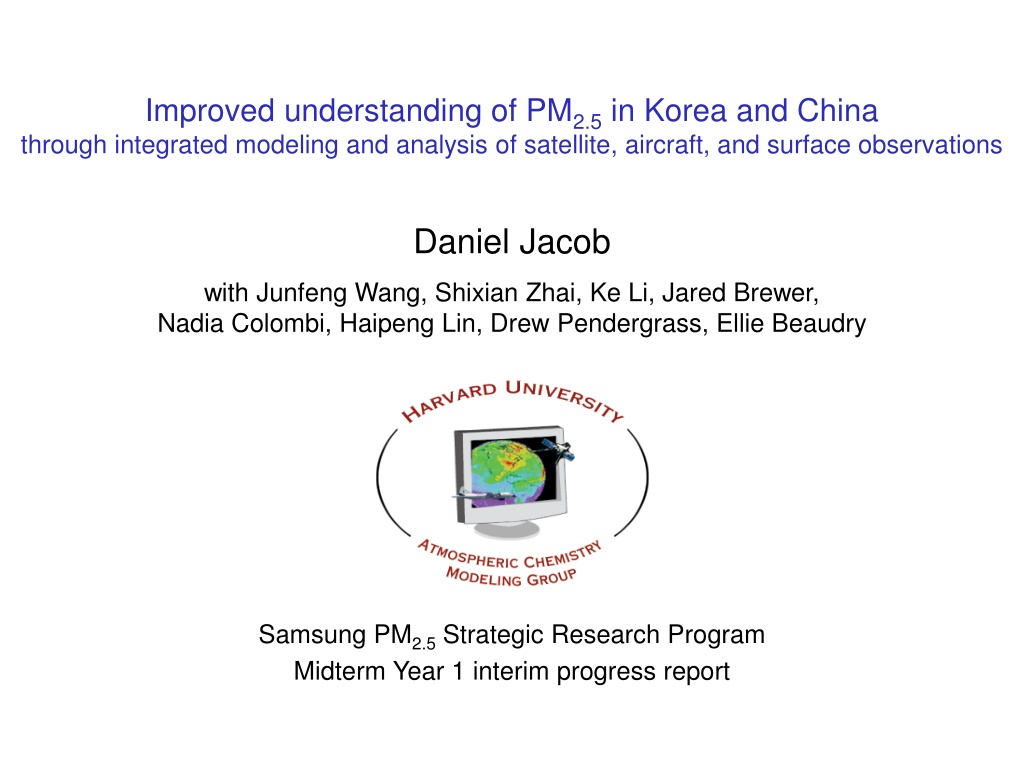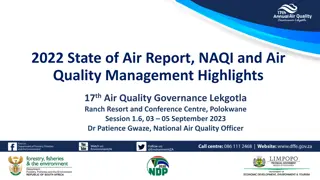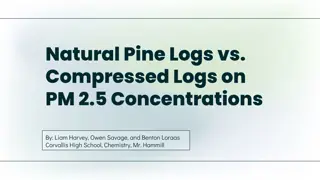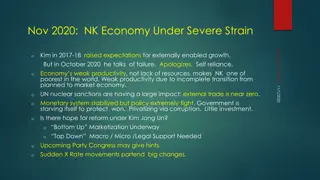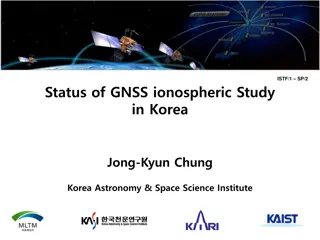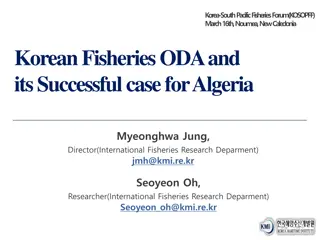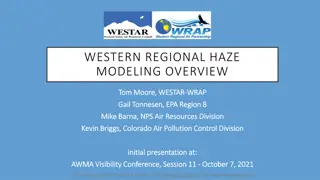Understanding PM2.5 in Korea and China Through Integrated Modeling and Analysis
Improved understanding of PM2.5 in Korea and China is achieved through integrated modeling of satellite, aircraft, and surface observations. Studies show fast oxidation of SO2 to sulfate PM during winter haze events, with correlations of sulfate with nitrogen oxides explained in-depth. The persistence of wintertime nitrate PM in China despite NOx emission reductions raises questions about chemical responses in winter haze. Negative impacts are observed upon decreases in NOx emissions, highlighting the complexities of air pollution dynamics under different conditions.
Download Presentation

Please find below an Image/Link to download the presentation.
The content on the website is provided AS IS for your information and personal use only. It may not be sold, licensed, or shared on other websites without obtaining consent from the author. Download presentation by click this link. If you encounter any issues during the download, it is possible that the publisher has removed the file from their server.
E N D
Presentation Transcript
Improved understanding of PM2.5in Korea and China through integrated modeling and analysis of satellite, aircraft, and surface observations Daniel Jacob with Junfeng Wang, Shixian Zhai, Ke Li, Jared Brewer, Nadia Colombi, Haipeng Lin, Drew Pendergrass, Ellie Beaudry Samsung PM2.5 Strategic Research Program Midterm Year 1 interim progress report
Stage II Stage I Stage II Clean Stage I Clean Stage II Clean Stage II Clean Explaining the fast oxidation of SO2 to sulfate PM in winter haze 4 WS (m s 2 0 B RH associated with High RH, clouds Fast SO2 oxidation High ammonia High HONO, N2O A 1200 A 1200 (m AGL) (m AGL) -1) December 16-22 2016 winter haze event at Beijing IAP moderate RH high RH cold front 4 -1) MLH MLH WS 600 (m s 600 2 PM2.5 > 400 g m-3 0 0 0 B 0.4 0.4 80 80 -3) RH (%) -3) RH (%) LWC LWC (g m (g m 0.2 0.2 40 40 LWC HONO 0.0 0 0.0 0 C C 10 10 330 330 HONO (ppb) HONO (ppb) (ppb) (ppb) N2O N2O 5 5 320 N2O 320 0 100 0 100 PM1 nitrate D PM1 nitrate D NO2 -3) 60 -3) 60 (ppb) (ppb) ( g m NO2 ( g m NO2 50 50 30 30 nitrate 0 0 0 0 E E SO2 20 PM1 sulfate 20 PM1 sulfate 60 60 (ppb) (ppb) -3) -3) SO2 SO2 10 10 30 ( g m sulfate 30 ( g m 0 0 0 0 F F 30 30 40 40 NH3 (ppb) (ppb) (ppb) (ppb) NH3 NH3 O3 O3 15 15 O3 20 20 0 0 0 0 G G 30 30 PM2.5 ( g m -3) ( g m -3) 400 -3) 400 -3) PM2.5 PM2.5 ( g m ( g m 15 15 BC BC 200 200 BC 0 0 0 0 20 Date 4 16 17 18 19 21 22 Date 4 16 17 18 December 2016 19 20 21 22 5 5 Wang et al., Nature Comm. 2020 Junfeng Wang December 2016, local time, UTC+8 December 2016, local time, UTC+8
Correlation of sulfate with nitrogen oxides in Dec 16-22, 2016 event moderate RH stage high-RH stage (night only) Fast sulfate and N2O production in high-RH stage can be explained by in-cloud oxidation of SO2 by NO2 and HONO: inversion H O - 3 2- 4 + NO (aq) + HSO NO + SO + 2H 2 Cloud pH >5 ~1 h 2 2 NO - 3 2- 4 NO (aq) + HSO N O + SO +... 2 2 2 possibly general mechanism for sulfate formation in winter haze sulfate, N2O SO2 NOx NH3 Wang et al., 2020
Why is wintertime nitrate PM in China not decreasing? Wintertime PM2.5 and nitrate at Beijing IAP, 2014-2019 Nitrate does not decrease (and increases during haze events) despite 43% reduction in Beijing NOx emissions Zhai et al., submitted to PNAS Shixian Zhai
Negative chemical responses in winter haze to NOx emission decreases sulfate decrease OH O3 NOxlifetime 22% gas PM OH, O3 NO3- NOx HNO3 NO3-/HNO3(g) Total nitrate lifetime 37% slow fast ammonia NOxemissions 43% Surface GEOS-Chem model results Decreasing NOx emissions causes an increase in nitrate under winter haze conditions; decreasing nitrate will require reduction in ammonia emissions Zhai et al., submitted
Continued increase of summer ozone in N. China Plain through 2019 Ozone increase due to continued decrease of NOx and PM2.5 while VOCs stay flat Decreasing ozone will require reduction of VOC emissions Li et al., ACPD 2020 Ke Li
COVID-19 lockdown reveals fast wintertime ozone production Beijing observations and model before Jan 24 after Jan 24 MDA8 ozone in N China Plain MDA8 ozone PM2.5 TROPOMI NO2 TROPOMI HCHO Observations Model PAN As NOx emissions decrease during lockdown, ozone production surges Formaldehyde from VOCs provides the main radical source Li et al., in prep.
Decreasing NOx combined with very high VOCs is now causing ozone pollution in China to extend into winter Maximum MDA8 ozone February March Li et al., in prep.
Can we use geostationary observations of aerosol optical depth (AOD) to infer surface PM2.5 and its sources? @550 nm Need to resolve: Inconsistency between GOCI and AHI geostationary observations which to use? Differing seasonality of AOD and PM2.5, which implies need for model information Shixian Zhai, in progress
AOD during KORUS-AQ aircraft campaign (May-Jun 2016) AHI GOCI GEOS-Chem Need to use AERONET, aircraft extinction profiles to evaluate satellite data Need to resolve model underestimate of extinction profiles Observed GEOS-Chem GEOS-Chem Altitude, km extinction coefficient, km-1 KORUS-AQ flight tracks Shixian Zhai, in progress
Vertical profiles of PM components in KORUS-AQ Observed GEOS-Chem GEOS-Chem Altitude, km km-1 g sm-3 Several questions to be resolved: 1. Are aircraft data from different instruments consistent? 2. Why does the model overestimate nitrate? 3. Why does the model underestimate sulfate, OA? 4. What is the contribution of dust to AOD, nitrate uptake? 5. Is there model bias in aerosol optical properties? 6. How do the aircraft data relate to surface PM2.5 observations? Jared Brewer and Shixian Zhai, in progress Jared Brewer
Surface PM2.5 components (g m-3) during KORUS-AQ Observations (circles), model (background) Total PM2.5 Model biases vs. surface sites are consistent with aircraft Shixian Zhai and Jared Brewer, in progress
Other projects spinning up Understand background contribution to surface ozone over Korea through integrated analysis of surface, sonde, aircraft, and satellite data Nadia Colombi Apply high-resolution WRF-GEOS-Chem (WRF-GC) to simulation of KORUS-AQ period Haipeng Lin Use machine learning to relate geostationary satellite AODs to surface PM2.5 in China and Korea Drew Pendergrass Use new GEMS geostationary observations to better understand emissions and chemistry related to PM2.5 and ozone in Korea and China Ellie Beaudry
